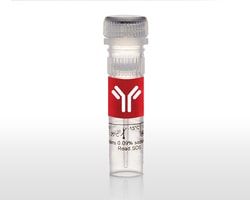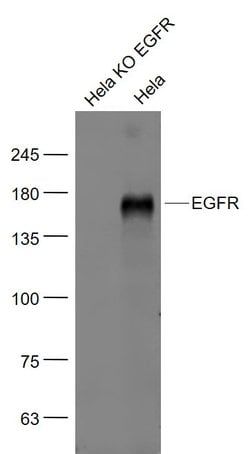COX4 Mouse anti-Human, Clone: 8D8, Bioss
Manufacturer: Bioss
Select a Size
| Pack Size | SKU | Availability | Price |
|---|---|---|---|
| Each of 1 | 50-197-9921-Each-of-1 | In Stock | ₹ 10,132.65 |
50-197-9921 - Each of 1
In Stock
Quantity
1
Base Price: ₹ 10,132.65
GST (18%): ₹ 1,823.877
Total Price: ₹ 11,956.527
Antigen
COX4
Classification
Monoclonal
Concentration
1 μg/mL
Formulation
PBS with 1% BSA, 50% glycerol and 0.09% sodium azide; pH
Gene Accession No.
P13073, Q96KJ9
Gene Symbols
COX4I1, COX4I2
Immunogen
Recombinant human COX4 protein.
Quantity
100 μL
Primary or Secondary
Primary
Target Species
Human
Product Type
Antibody
Isotype
IgG
Applications
Immunofluorescence, Immunohistochemistry (Paraffin), Western Blot
Clone
8D8
Conjugate
Unconjugated
Gene
COX4I2
Gene Alias
AL024441; BOS_13182; BOS_17018; COX; COX IV-1; COX IV-2; COX4; COX4-1; COX4-2; Cox4a; Cox4b; COX4I1; cox4i1.S; Cox4i2; COX4L2; coxiv; COXIV-1; CoxIV-2; Cytochrome c oxidase polypeptide IV; Cytochrome c oxidase subunit 4 isoform 1, mitochondrial; cytochrome c oxidase subunit 4 isoform 1, mitochondrial-like; Cytochrome c oxidase subunit 4 isoform 2, mitochondrial; cytochrome c oxidase subunit 4I1; cytochrome c oxidase subunit 4I2; cytochrome c oxidase subunit IV; Cytochrome c oxidase subunit IV isoform 1; cytochrome c oxidase subunit IV isoform 1 S homeolog; Cytochrome c oxidase subunit IV isoform 2; cytochrome c oxidase subunit IV isoform 2 (lung); cytochrome c oxidase subunit IV-like 2; cytochrome c oxidase, subunit 4a; cytochrome c oxidase, subunit 4b; cytochrome c oxidase, subunit IV; cytochrome c oxidase, subunit IVa; cytochrome c oxidase, subunit IVb; cytochrome c oxydase subunit 4; dJ857M17.2; FLJ23483; hypothetical protein MGC73355; IV-1; LOC100624067; mg:bb02d03; MGC72016; XELAEV_18024950mg; zgc:110058; zgc:73355
Host Species
Mouse
Purification Method
Protein G
Regulatory Status
RUO
Gene ID (Entrez)
1327, 84701
Content And Storage
-20°C
Form
Liquid
Description
- Cytochrome c oxidase (COX) is the terminal enzyme of the mitochondrial respiratory chain
- It is a multi-subunit enzyme complex that couples the transfer of electrons from cytochrome c to molecular oxygen and contributes to a proton electrochemical gradient across the inner mitochondrial membrane
- The complex consists of 13 mitochondrial- and nuclear-encoded subunits
- The functions of the nuclear-encoded subunits are unknown but they may play a role in the regulation and assembly of the complex
- COX4 (COX4I1) is one of the nuclear-coded polypeptide chains of cytochrome c oxidase, the terminal oxidase in mitochondrial electron transport.







